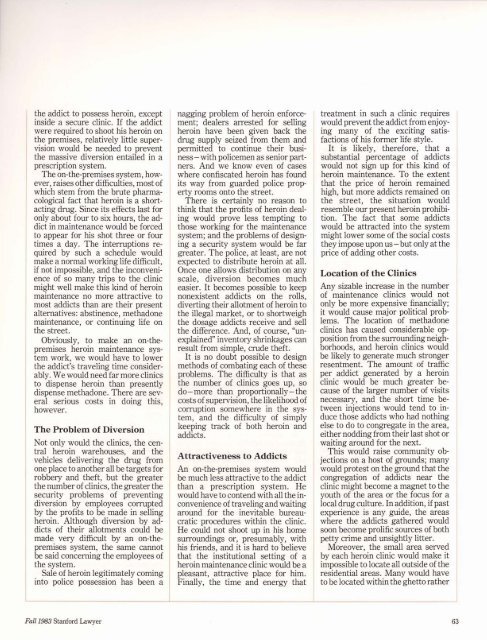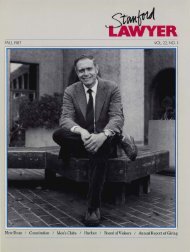it will be less so if we adopt a heroinmaintenance system. Indeed, thereare reasons to think that more nonaddictswill be able to purchaseheroin under a prescription maintenancesystem.One reason would be the greatersocial integration of the new class ofsellers. Freeing addicts from theneed to pursue their own heroin requirementsmakes it easier for themto integrate themselves into moreareas of our society. Indeed, that isone of the purposes of heroin maintenance.The problem is that so manyaddicts have become more adept atillegal than legal methods of earningincome. The likely prospect is thatmany of them would supplementtheir incomes by selling some oftheir prescribed heroin to their new,nonusing associates.The effect of a prescription system,then, would be to expose amuch larger segment of the populationto access to heroin. It would notonly lower the financial cost of thedrug to large numbers of people, itwould greatly lower the nonfinancialcosts as well-the difficulty, inconvenience,and danger of obtainingheroin.Enrollment of NonaddictsNonaddicts might even be able toobtain heroin through the prescriptionsystem directly rather than indirectlyfrom those addicts inmaintenance. It has been allegedthat the almost automatic provisionof welfare payments to those enrolledin certain methadone programshas acted as a significantinducement to nonaddicted heroinusers, and even some nonusers, topass themselves off as addicts andenter maintenance.Similarly, the opportunity to profitfrom the sale of prescribed heroincan act as an incentive to both addictsand nonaddicts to enter themaintenance system. The incomefrom heroin sales would presumablybe considerably greater than thatfrom welfare payments today, andwould provide a more exciting and,in some circles, a more respectableway of earning a living.Unfortunately this income wouldbe gained at considerable social cost.It would increase the number ofheroin sellers, increase the costs ofthe maintenance system by addingextra clients, and be a far more explosiveissue politically than welfareis today.It is true that if a heroin maintenanceprogram were run with considerablecare, it could avoid takingmost nonaddicts onto its rolls. Thisis not, however, so easy as mightappear.Although we tend to use the term"addiction" as if it were a precise,either/or condition, the fact is that itis a very imprecise term. Often thequestion of addiction will turn out tobe one of degree - and even then dependentupon the expectations of theuser.Admittedly, injection of an opiateantagonist will throw into withdrawalsomeone with a relativelylow degree of physical dependence,while it will not affect a mere user.There are disadvantages in thissomewhat drastic screeningmethod, however. First of all it islikely to make signing up for themaintenance program considerablyless attractive to those who are addicted.More important, it requires aconsiderable degree of care and skillto administer - characteristics whichmay not always be in great supply ifheroin maintenance proliferates.Worse yet, our experience withmethadone programs gives us reasonto expect that patients and staffwill sometimes collude. Prospectivepatients counterfeit addiction forvarious reasons. The staff membersignore the safeguards meant to barnonaddicts, both because the supportfor such clinics is based on a perpatient payment and because theyare sympathetic with the reasons thenonaddict wants to join. This, as wewill see, has been a problem withmaintenance systems using methadone,a much less troublesome andless attractive drug than heroin. Wewould have to expect that considerablymore would go wrong with anysystem making use of heroin itself.Costs of a PrescriptionSystemA prescription heroin maintenancesystem would entail significant administrativecosts. First of all, onpurely therapeutic grounds, it wouldentail expenses for monitoring andprescribing for the addicts.In addition, we would need to establishcareful controls to preventthe wholesale embezzlement of heroin.We would have to invest a considerableamount in auditing thepractices of clinics to prevent prescriptionfraud and other corruption-though, of course, our effortscould never be completely successful.Similarly, the pharmacies thatfilled the prescriptions would have tobe protected from robbery as well asembezzlement.Finally, the social cost of a prescriptionmaintenance system includesnot only the resourcesexpended on it and the increases inaddiction it might bring, but also theresults of the inevitable police effortsto stem the tide of diversion. Thegreater these efforts, the more theoverall system takes on the disadvantagesof our present heroin prohibition,in the consumption of lawenforcement resources, fostering ofpolice corruption, and violations ofcivil liberties.On-the-Premises SystemThe intractable problem of diversionfrom a prescription maintenancesystem forces one to examinemore carefully the other major typeof heroin maintenance: the on-thepremisessystem. Here, diversionwould be minimized by not allowing62<strong>Stanford</strong> <strong>Lawyer</strong> <strong>Fall</strong> <strong>1983</strong>
the addict to possess heroin, exceptinside a secure clinic. If the addictwere required to shoot his heroin onthe premises, relatively little supervisionwould be needed to preventthe massive diversion entailed in aprescription system.The on-the-premises system, however,raises other difficulties, most ofwhich stem from the brute pharmacologicalfact that heroin is a shortactingdru'g. Since its effects last foronly about four to six hours, the addictin maintenance would be forcedto appear for his shot three or fourtimes a day. The interruptions requiredby such a schedule wouldmake a normal working life difficult,if not impossible, and the inconvenienceof so many trips to the clinicmight well make this kind of heroinmaintenance no more attractive tomost addicts than are their presentalternatives: abstinence, methadonemaintenance, or continuing life onthe street.Obviously, to make an on-thepremisesheroin maintenance systemwork, we would have to lowerthe addict's traveling time considerably.We would need far more clinicsto dispense heroin than presentlydispense methadone. There are severalserious costs in doing this,however.The Problem of DiversionNot only would the clinics, the centralheroin warehouses, and thevehicles delivering the drug fromone place to another all be targets forrobbery and theft, but the greaterthe number of clinics, the greater thesecurity problems of preventingdiversion by employees corruptedby the profits to be made in sellingheroin. Although diversion by addictsof their allotments could bemade very difficult by an on-thepremisessystem, the same cannotbe said concerning the employees ofthe system.Sale of heroin legitimately cominginto police possessio!! has been anagging problem of heroin enforcement;dealers arrested for sellingheroin have been given back thedrug supply seized from them andpermitted to continue their business-withpolicemen as senior partners.And we know even of caseswhere confiscated heroin has foundits way from guarded police propertyrooms onto the street.There is certainly no reason tothink that the profits of heroin dealingwould prove less tempting tothose working for the maintenancesystem; and the problems of designinga security system would be fargreater. The police, at least, are notexpected to distribute heroin at all.Once one allows distribution on anyscale, diversion becomes mucheasier. It becomes possible to keepnonexistent addicts on the rolls,diverting their allotment of heroin tothe illegal market, or to shortweighthe dosage addicts receive and sellthe difference. And, of course, "unexplained"inventory shrinkages canresult from simple, crude theft.It is no doubt possible to designmethods of combating each of theseproblems. The difficulty is that asthe number of clinics goes up, sodo-more than proportionally-thecosts of supervision, the likelihood ofcorruption somewhere in the system,and the difficulty of simplykeeping track of both heroin andaddicts.Attractiveness to AddictsAn on-the-premises system wouldbe much less attractive to the addictthan a prescription system. Hewould have to contend with all the inconvenienceof traveling and waitingaround for the inevitable bureaucraticprocedures within the clinic.He could not shoot up in his homesurroundings or, presumably, withhis friends, and it is hard to believethat the institutional setting of aheroin maintenance clinic would be apleasant, attractive place for him.Finally, the time and energy thattreatment in such a clinic requireswould prevent the addict from enjoyingmany of the exciting satisfactionsof his former life style.It is likely, therefore, that asubstantial percentage of addictswould not sign up for this kind ofheroin maintenance. To the extentthat the price of heroin remainedhigh, but more addicts remained onthe street, the situation wouldresemble our present heroin prohibition.The fact that some addictswould be attracted into the systemmight lower some of the social coststhey impose upon us - but only at theprice of adding other costs.Location of the ClinicsAny sizable increase in the numberof maintenance clinics would notonly be more expensive financially;it would cause major political problems.The location of methadoneclinics has caused considerable oppositionfrom the surrounding neighborhoods,and heroin clinics wouldbe likely to generate much strongerresentment. The amount of trafficper addict generated by a heroinclinic would be much greater becauseof the larger number of visitsnecessary, and the short time betweeninjections would tend to inducethose addicts who had nothingelse to do to congregate in the area,either nodding from their last shot orwaiting around for the next.This would raise community objectionson a host of grounds; manywould protest on the ground that thecongregation of addicts near theclinic might become a magnet to theyouth of the area or the focus for alocal drug culture. In addition, if pastexperience is any guide, the areaswhere the addicts gathered wouldsoon become prolific sources of bothpetty crime and unsightly litter.Moreover, the small area servedby each heroin clinic would make itimpossible to locate all outside of theresidential areas. Many would haveto be located within the ghetto rather<strong>Fall</strong> <strong>1983</strong> <strong>Stanford</strong> <strong>Lawyer</strong>63
- Page 1 and 2:
RFAll 1983VOL. 18, NO.1Heroin Optio
- Page 3 and 4:
jah(e,oYCONTENTSSTANFORD lAWYEREdit
- Page 5 and 6:
Business Law vs. Public Interest La
- Page 7 and 8:
By John Kaplanjockson Eli ReynoldsP
- Page 9 and 10:
maintenance almost entirely up toth
- Page 11:
smaller percentage of British addic
- Page 14 and 15: that, because of regulation, cannot
- Page 16 and 17: of a whole variety of new mortgagei
- Page 18 and 19: ConversationsWith Five AlumniBy Mic
- Page 20 and 21: y landlords and tenants about rents
- Page 22 and 23: when I was studying law and she was
- Page 24 and 25: ~o(1)AtISSUE *Union 'Rights' in the
- Page 26 and 27: AtISSUECongressional Responses toSu
- Page 28 and 29: AtISSUEPrison Labor:TimeTo Take Ano
- Page 30 and 31: Graduates and friends of theSchool
- Page 32 and 33: ~o~ 4'-VVcYi~STATE OF THE SCHOOLJoh
- Page 34 and 35: ~o~ Cff-VIMtu'0r-STATE OF THE SCHOO
- Page 36 and 37: ~o~ 4-(/141~STATE OF THE SCHOOL con
- Page 38 and 39: ~o~4VJ41~SUCCESSFUL LAWYERING:IMPLI
- Page 40 and 41: ~o~of-VJM~SUCCESSFUL LAWYERING cont
- Page 42 and 43: @.oarcA 4l!141~THE CONSTITUTION, RA
- Page 44 and 45: @o~4t1J41~.LAW AND BUSINESS PROGRAM
- Page 46 and 47: @otwrA 4vJ41~ .SUMMARY AND ADVISORY
- Page 48 and 49: David L. Engel(Harvard, JD '73)Bost
- Page 50 and 51: New Faculty (cont.)Michigan Law Sch
- Page 52 and 53: GILSON (cant.)Gilson is currently p
- Page 54 and 55: BabcockAwarded anHonorary LL.D.by S
- Page 56 and 57: CAREER 'ALTERNATIVES' (cant.)2. A s
- Page 58 and 59: Hurlbut WinnerTalks AboutTeachingPr
- Page 60 and 61: Schod;NI Grads Scatter toCities All
- Page 62 and 63: FACULTV NOTES (cant.) Professor Gun
- Page 66 and 67: than on its edges, thus increasing
- Page 68 and 69: Heroin maintenance is, in manyways,
- Page 70 and 71: c~OTESII1912-25Hon. David Lee Rosen
- Page 72 and 73: c~NOTESthe firm advises, that "Donn
- Page 74 and 75: c~NOTESand had been prominent in a
- Page 76 and 77: spring Dean Ely traveledLEast, wher
- Page 78 and 79: 5Stanford LaWlers:This Page IsYours
- Page 80 and 81: October 11Washington, DC LawSociety
- Page 82 and 83: COMPARATIVE CONTRIBUTIONS TOTHE LAW
- Page 84 and 85: A MESSAGE FROM THELAW FUND PRESIDEN
- Page 86 and 87: CLASSAGENTSLong BeachSterling S. Cl
- Page 88 and 89: Warren Christopher'49 Penny Howe Ga
- Page 90 and 91: Frank L. Mallory '47Richard C. Mall
- Page 92 and 93: Ronald G. Trayner '67Anthony J. Tre
- Page 94 and 95: Walter A. Johnson, A.B. '29 Maxine
- Page 96 and 97: DONORS TO THE LAW FUND• Hon. Murr
- Page 98 and 99: CLASS OF 1948R. Winfield AchorHon.
- Page 100 and 101: • Thomas R. MitchellR. Chandler M
- Page 102 and 103: Paul E. Kreutz• Prof. Richard B.
- Page 104 and 105: Gabriel M. GesmerMichael GilfixCorn
- Page 106 and 107: HIGHEST LEVELSOF PARTICIPATIONLARGE
- Page 108 and 109: FACULTY, FORMERFACULTY &STAFFBarbar
- Page 110 and 111: REUNION GIVINGWhile class reunions
- Page 112 and 113: DONORS TO SPECIALPROGRAMS AND FUNDS
- Page 114 and 115:
Class of 1954 Reunion Student Finan
- Page 116 and 117:
In Memory of:Clifton C. Cottrell '2
- Page 118 and 119:
Clyde E. Tritt'49William W. VaughnS
- Page 120:
BEQUESTS AND DEFERRED GIVINGBequest
















